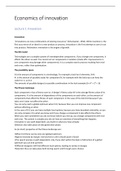Economics of innovation
Lecture 1 Innovation
Innovation
“Innovations are new combinations of existing resources” (Schumpeter, 1934). While invention is the
first occurrence of an idea for a new product or process, innovation is the first attempt to carry it out
into practice. Motivation: innovation is the engine of growth.
The NK model
Technologies are a complex system of interdependent components. If you change one component, it
affects the others as well. You cannot act on components in isolation (trade-offs: improvements in
one component may damage other components). It is a complex search process resulting from trial
and error, rather than optimization.
The possibility space
N is the amount of components in a technology. For example a lock has 4 elements, N=4.
An is the amount of possible states for component N, for example with the locks you can have the
code 0 or 1, so A=2.
The amounts of possible designs (or possible combinations in the lock example) S= An = 24 = 16.
The fitness landscape
Each component n has a fitness score w. A design’s fitness value W is the average fitness value of its
components. K is the amount of dependence of the components on each other, so the amount of
components that affect the fitness of each component. In the case of the lock K=0 because if you
twist one it does not affect the other.
You can only reach a global optimum when K=0, because then you can improve one component
without affecting an other.
In the case of K=2 you can have multiple local optima, because you have bounded rationality, so you
can only compare it to what you know and if you change a component it also affects the others.
When you start somewhere you do not know where you end up, you change components with trial
and error. The system is complex you do not have an overview of everything that happens.
Innovation is very path dependent, you build on what you have already.
Selection also takes place at idea generation phase.
So (in short) properties of the fitness landscape are:
•When K=0 there can be only one (global) optimum.
•Agents innovate by myopic trial-and-error until a (local) peak is found
•The search process is path dependent: only if you start within the basin of attraction of a global
optimum you can end up there.
•Different designers will find different local optima, leading to variety in designs
•Selection thus can take place both during search and through users choices
,In this landscape you see if you change one component, both other components are also changes in
fitness score (K=2). You always want to move to a higher fitness score.
The example of Northrop
Technical development proceeds with uncertain changes and the outcome is often unforeseeable.
With the airplanes, there were wo local optima: Northrop: Fixed landing gear; Compartment wings
and competitors: Retractable landing gear; Hollow. While in hindsight we may think of Northrop’s as
a bad design, its development was just as rational as the development of its ‘brilliant’ alternative. It is
a good example of variation-selection; it provided different type of landing gears. Individual
designers, using variation-selection in some form, make decisions in the course of solving specific
problems.
Decomposability
On the vertical axis you have N1, N2 etc. and on the horizontal you have w1, w2 (fitness) etc. For
example when K=0 if you change an element of N1 it affects w1.
On the matrix on the left: N=6 and K=1, if you change one component you affect one other besides
themselves, and A= 2 (black or white in this case), S= 26 = 64. You cannot split the system.
On the right: K=2, N=6. Here you can split the system in two subsystems, both N=3, S = 23 + 23 = 16.
Advantage of this is that the number of trials is smaller, you have less combinations to try (and trials
can be expensive and time consuming).
The matrix on the left can be beneficial too when you have competitors, because a complex system is
harder to imitate.
Architectural innovation
, Architectural innovation can be defined as a change in the way components are linked to each other,
while the core design concepts remain untouched. This would be mutation that affects the K of the
fitness landscape. Different type of innovations can be divided into categories by if the way
components are linked to each are changed and if the core design components are changed.
Architectural innovation can be seen as both competence enhancing and destroying. It destroys the
usefulness of a firm's architectural knowledge but preserves the usefulness of its knowledge about
the product's components. Also, with radical innovation it becomes clear for a company that is it a
radical innovation since the core concepts are also changed. The introduction of new linkages,
however, is much harder to spot. Since the core concepts of the design remain untouched, the
organization may mistakenly believe that it understands the new technology.
Lecture 2 Diffusion
Technology diffusion
Innovation is an invention that gets commercialised. Diffusion is important for innovation because it
is essential for it to be an innovation, because it is essential for it to be spread on the market.
Understanding the process of technological diffusion is essential to gain any insight into the
processes of economic growth. The application of innovation, and not just the idea of the invention
or the generation of the innovation, brings the benefits from technological advance. Also, the cost of
production goes down with quantity and also the quality goes up, so this happens if you diffuse
more.
Learning curve
As organizations produce more of a product, the unit cost of production typically decreases at a
decreasing rate. This happens because the more you practice the more you learn. Learning rates
differ per company, because they have different skills, goals and companies are heterogeneous. It is
also path dependence.





